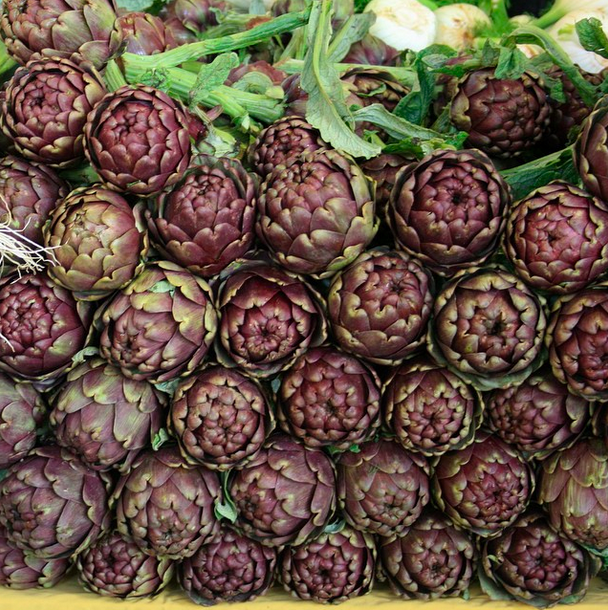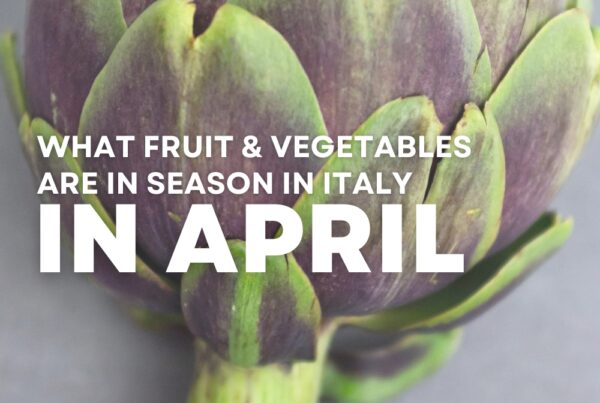Produce is of much better quality and is a million times tastier when eaten in season!
With the holidays behind us and our new year’s resolutions marked with the promise to eat healthier, we should be reminded that Nature’s calendar is the best checklist for our alimentary intentions.
Here is a list of fruits, vegetables and nuts that are in season in January in the northern hemisphere, and commonly gracing the stalls of markets in Italy.
VEGETABLES
Violet Artichokes
The wonderful ‘romaneschi’ artichokes Rome is best known for don’t appear until February and the sensational Roman Mammole bloom in April-May when they are at their peak, but early in January you can certainly enjoy spiny violet artichokes cooked in every which way, even raw, dipped in olive oil and lemon.
Beetroot
Thanks to its earthy, rich and sweet flavor and distinctive vibrant color, beetroots lend themselves to a variety of both sweet and savory preparations. Their feathery fronds sauteed with olive olive and garlic are equally delicious.
Brussel sprout
Kids love the “miniature cabbages”, and Brussel sprouts make their appearance on Italian market stalls between October and March, budding in multiple rows on a thick, central stalk. A true winter staple, these can be halved, tossed with olive oil, salt and pepper and roasted for a nice seasonal kick that keeps the cold season at bay.
Cabbage
Different varieties of cabbage are available all year round. The cabbage, or brassica, family is huge, and includes everything from the familiar red, white or green varieties with heavy heads of tightly packed leaves, to cauliflower, broccoli as well as bok choi, popular in Asian cookery. Cabbage itself comes in many forms, and shapes can be flat, conical or round, the heads compact or loose, and the leaves curly or plain. The round, crinkle-leafed Savoy cabbage is considered culinarily superior. Essential to good soups or a bollito misto, cabbage lends a nutty, rich flavor to all it comes in contact with.
Cauliflower
At its best from mid December through to mid April, cauliflower comes in many other colors besides cream white: there are various purple shades, dark brown and bright yellow. In Italy we have several varieties, the round white head, whose stalk and green thick outer leaves are often (and unjustly) discarded, and the unique pointy green Romanesco head, perfect example of fractal geometry in nature, with its branched floret making a logarithmic spiral, repeating itself in self-similarity at varying scales.
Cavolo nero
Super food par excellence, cavolo nero (aka lancinato kale, Tuscan kale, black kale or dinosaur) is the popular loose-leafed cabbage from Tuscany whose leaves are a very dark green, almost black, with pleasantly tangy, bitter flavor and a sweet aftertaste. It is a popular ingredient in many classic Italian soups like Ribollita or Zuppa di Magro and is essential for Minestrone.
Celeriac
The unsung hero of the vegetable world is available year round but is at its best from September to April. Celeriac is easily spotted on the market stall as the weird root with knobby, rhino-tough skin. The surprise is instead the subtle, celery-like flavor, with nutty overtones. Try it as mash, in big-flavored, slow-cooked stews, or in its classic form – remoulade – as they do en France.
Celery
Sedano, in Italian, is available all year round, but the season here runs from late July to late February. The tougher outer stalks are the best to cook with, the inner, more tender ribs are better for eating raw. The leafy tops are a great addition to salads. It is essential in mirepoix – the carrot, onion and celery holy trinity that is the starting point of many dishes.
Leek
Although more closely related to garlic, leeks taste more like a mild onion but with a hint of sweetness. Available all year round, but at their best from September to March, leeks are very versatile and work well used in various recipes, or cooked by itself as a side dish.
Lettuce
Lettuce is available all year round in a vast number of varieties, either crisp or floppy. Mainly eaten raw in salads, Italians also add lettuce to soups or braise them as a side dish. Among the most commonly available lettuces in Italy during winter are curly endive (Frisée), Escarole endive, and Catalogna endive, which in Rome is called puntarelle.
Radicchio
Radicchio’s distinctive red and white leaves are a true hallmark of winter in Italy. Either tapered or shaped like a small cabbage, radicchio in Italy is used both raw in salads, or grilled, braised or cooked in risotto. Radicchio comes in several varieties, the most famous being Rosso di Treviso, which can be either Precoce: fleshy red leaves with white ribs that form a compact bunch, or Tardivo: harvested in January, which has much more pronounced ribs and splayed leaves, is more flavorful, with stronger bitter accents.
Scorzonera (Salsify)
This European root of the dandelion family is also known as the oyster plant because of its oystery taste when cooked. The root is similar in appearance to a long, thin tapered parsnip, with creamy white flesh and a thick skin. In season between August and May.
Tip: the milky juice released when peeling fresh salsify tends to stain, so better to handle it wearing gloves!
Topinambur (Jerusalem Artichoke)
At their best from November to March, this vegetable is not truly an artichoke but a lumpy, brown-skinned tuber that often resembles a ginger root. Contrary to what the name implies, this vegetable has nothing to do with Jerusalem. The white flesh of Topinambur is nutty, sweet and crunchy and is a good source of iron. The Piedmontese peel it and, once it’s cut in chunks, dip it in bagna càuda.
Turnip
You can buy winter turnips all year-round, although peak season is from October to February. Creamy-white with lovely purple, red or greenish upper part where the taproot has been exposed to sunlight. Before the arrival of the potato, turnips were one of the main sources of sustenance for Italian peasants. Turnip leaves or ‘greens’ (locally called cime di rapa) can also be eaten boiled, steamed, stir-fried. Orecchiette with Turnip greens are a typical Puglia specialty.
FRUIT
Apple
Available all year round, Italian apples are at their best from September through January. Cinnamony flavored and ugly-looking Annurche apples are a delight, and gourmands await winter months in order to indulge in these little mouthfuls of happiness. The most popular varieties besides the Annurche are Fuji, Gala, Granny Smith and Golden Delicious… the list goes on.
Clementine
Better catch them while they last, which is a small window between November and February. This sweetest variety of tangerine is flavorful and tangy, contains no seeds and is recognisable by its loose, baggy bright orange skin. Clementine segments can be eaten on their own or dipped in melted chocolate. The zest can be candied or used to make “mandarinetto” liqueur, a close relative of limoncello. As opposed to Mandarins, which originated in China, and Tangerines which arrived in Europe in the 1800’s by way of North Africa, exported through the port of Tangier (hence the name), the Clementine varietal was created by a French missionary in Algeria over 100 years ago, named Marie-Clement Rodier.
Lemon
At their best between January and March, lemons are one of the most versatile fruits around, and contain exciting levels of Vitamin C. The best lemons for juicing or using for wedges are those with a smooth, thin skin, while the best for zesting are those with thicker, knobbly skin, which tend to be larger. Always buy unwaxed lemons (shops should state this clearly), especially if you’ll be using them for zesting. If you can’t find unwaxed produce, scrub the lemons thoroughly with baking soda before zesting.
Tip: to extract the maximum amount of juice, make sure lemons are at room temperature, and roll them between your hands or on your kitchen counter.
Kaki (Persimmon)
Though originally from the Orient, you’ll see plenty of persimmon trees in the Italian countryside, which look bizarre with no leaves and plump fruits hanging from their naked branches. The actual fruits are quite firm until they ripen, at which point they become voluptuously soft, with a silky mouthfeel and the texture of a water balloon. The many varieties of persimmon ripen from September through December, but given this year’s warmer temperatures in Italy, January is still a good time for enjoying them here. Ripe persimmons are very delicate, and you’ll see them in Italian markets carefully packed in sets of three or four in padded styrofoam trays.
Orange
In season from November but at their peak in December-January, oranges originate in China where they were first cultivated around 2500 B.C. Oranges were introduced in Europe, and specifically Italy, by the crusaders in the XI century, grown widely in Sicily for medicinal purposes. Sweet oranges on the other hand remained unknown until the late XV century or the beginnings of the XVI century, when Italian and Portuguese merchants brought sweet orange trees into the Mediterranean.
Pomegranate
Pomegranates have always been highly prized for their flavor, but their recent emergence as a highly nutritious superfood, loaded with antioxidant vitamins, has made them even more popular. Available as the colder months set in, pomegranates appear in Italian markets in November in their shiny orbs, blushed with red or yellow. Inside, scores of edible tiny white seeds are held in jewel-like ruby sacs of sweet, juicy flesh. The sacs themselves are packed tightly in a bitter, pale yellow pith.
Pears
In season from September through to January, pears boast sweet, granular flesh which is delicate and that bruises easily when ripe, so always buy slightly underripe (they should be firm but not hard). Did you know pears ripen from the inside out?
Quince
When ripe, quince are very fragrant, with smooth, golden yellow skin. Their hard, bitter flesh is used almost exclusively for cooking. Once cooked, the flesh develops a deeper flavor and turns a golden pink. Quinces contain high level of pectin, which makes them great for making jellies, jams and other preserves, such as the Italian quince paste, cotognata, which is often served with cheese. Quinces are in season from late September through January.
NUTS & DRIED FRUIT
Chestnuts
Fresh chestnuts are around from the end of September to the end of January. Caldarroste (open fire-roasted chestnuts) are sold on the street in Italy, releasing their unique comforting and wintery aroma. The sweet, crumbly nut also provides Italians (and Tuscans, in particular) with chestnut flour which is employed in interesting desserts like castagnaccio (a gluten-free non-sweet dessert, added with raisins, pine nuts and rosemary needles) and necci, delightful chestnut flour pancakes. In contrast to other nuts, chestnuts have a low oil and a high water content (hence their unique, soft texture) and should never be eaten raw. An old Italian wives tale says eating raw chestnuts will give you head lice!
Dates
Dates are sweet, with a rich, deep flavor and a lush, slightly chewy texture. The mahogany brown Medjool variety is the sweetest, and tastes somewhat like toffee. Dates are one of the oldest cultivated fruits: it’s thought that they were a staple part of the Babylonian diet 8000 years ago. During the Christmas holidays (which in Italy last through January 6th with the Epifania – visitation of the Magi) Italians indulge in dried fruits and nuts, and dates – either stuffed with almonds, plain, or smeared with salted butter – are a big part of that sweet meal ending. Dried dates are available the whole year round, but the fresh type are at their best between November and January.
What fruit and vegetables are in season in January where you live?

















Well done, Ele. Time to eat my veggies, I guess…
Always eat your veggies! The healing powers of plants should not be overlooked either, so now in the midst of bombcyclone and flu season, it’s important to pack those vitamins with fruit and veg.